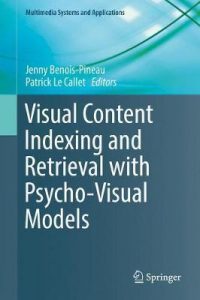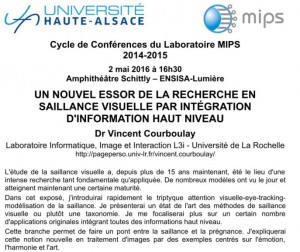I’m very pround to announce my chapter » Information – theoretical model for saliency prediction. Application to Attentive CBIR » in
Visual Content Indexing and Retrieval with Psycho-Visual Models
Edited by Jenny Benois-Pineau , Edited by Patrick Le Callet
Abstract : « This work presents an original informational approach to extract visual information, model attention and evaluate the efficiency of the results.
Even if the extraction of salient and useful information, i.e. observation, is an elementary task for human and animals, its simulation is still an open problem in computer vision. In this article, we define a process to derive specific and optimal laws to extract visual information and by the way model information without any constraints or a priori. Starting from saliency definition and measure through the prism of information theory, we present a framework in which we develop an ecological inspired approach to model visual information extraction. We theoretically demonstrate some results previously presented, for instance, in spites of being fast and highly configurable, our model is as plausible as existing models designed for high biological fidelity. It proposes an adjustable trade-off between nondeterministic attentional behavior and properties of stability, reproducibility and reactiveness. We apply this approach to enhance the performance in an object recognition task.
As a conclusion, this article proposes a theoritical framework to derive an optimal model validated by many experimentations. »
Even if the extraction of salient and useful information, i.e. observation, is an elementary task for human and animals, its simulation is still an open problem in computer vision. In this article, we define a process to derive specific and optimal laws to extract visual information and by the way model information without any constraints or a priori. Starting from saliency definition and measure through the prism of information theory, we present a framework in which we develop an ecological inspired approach to model visual information extraction. We theoretically demonstrate some results previously presented, for instance, in spites of being fast and highly configurable, our model is as plausible as existing models designed for high biological fidelity. It proposes an adjustable trade-off between nondeterministic attentional behavior and properties of stability, reproducibility and reactiveness. We apply this approach to enhance the performance in an object recognition task.
As a conclusion, this article proposes a theoritical framework to derive an optimal model validated by many experimentations. »


